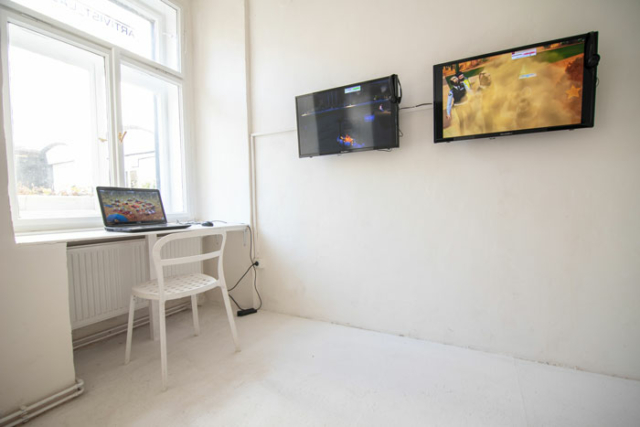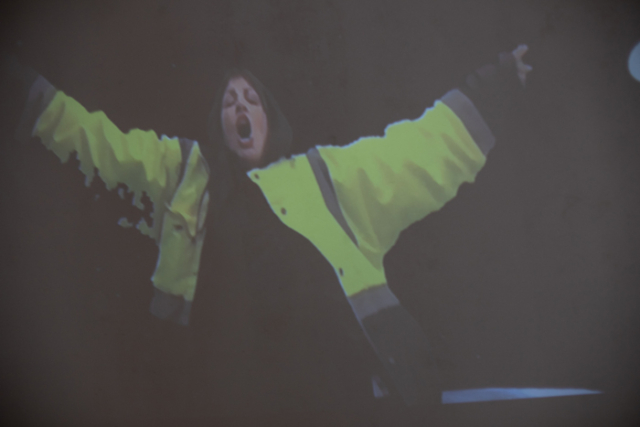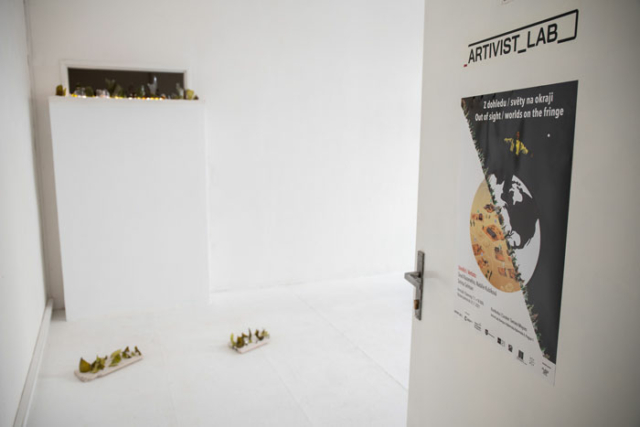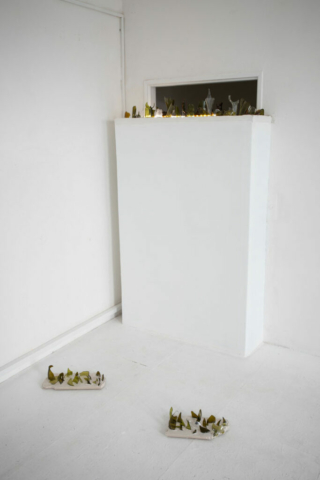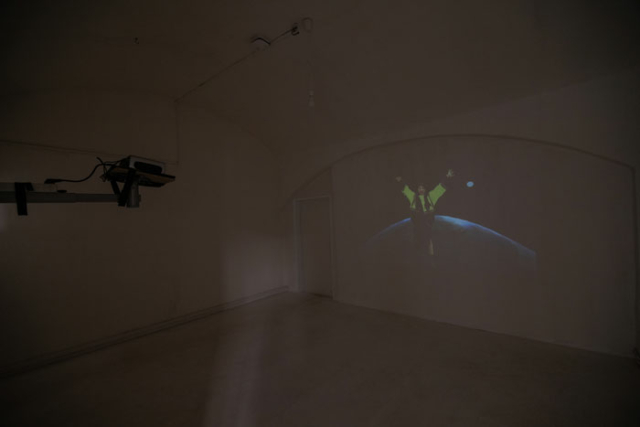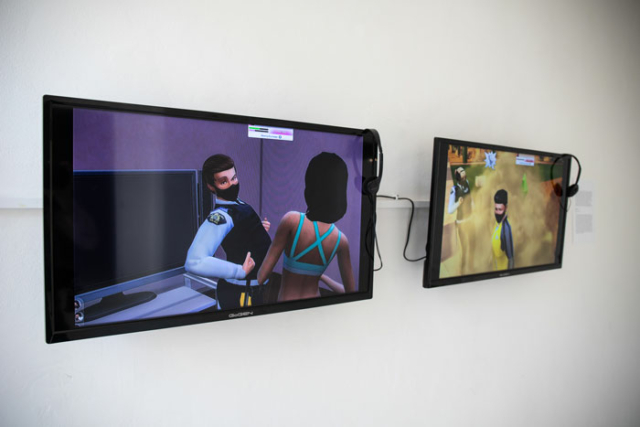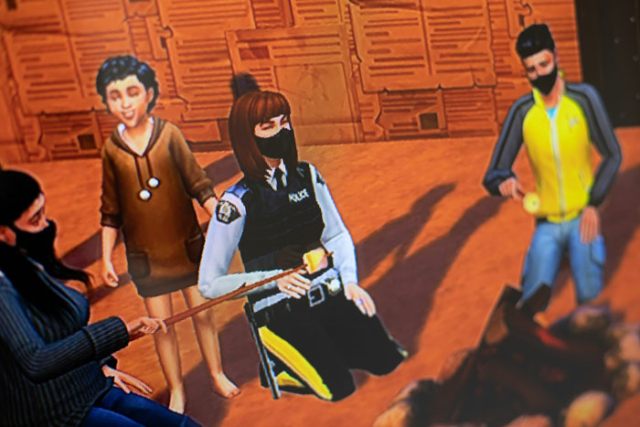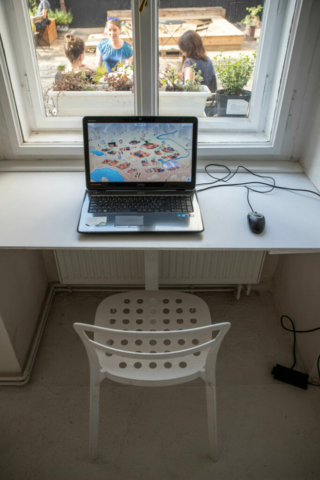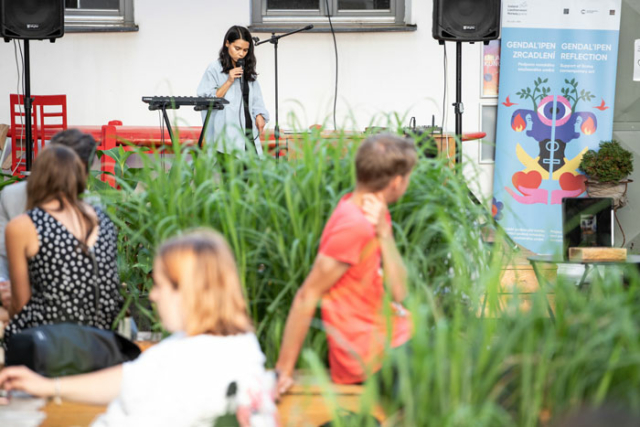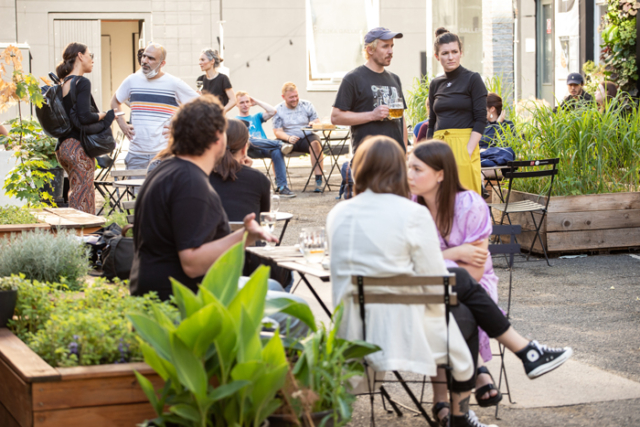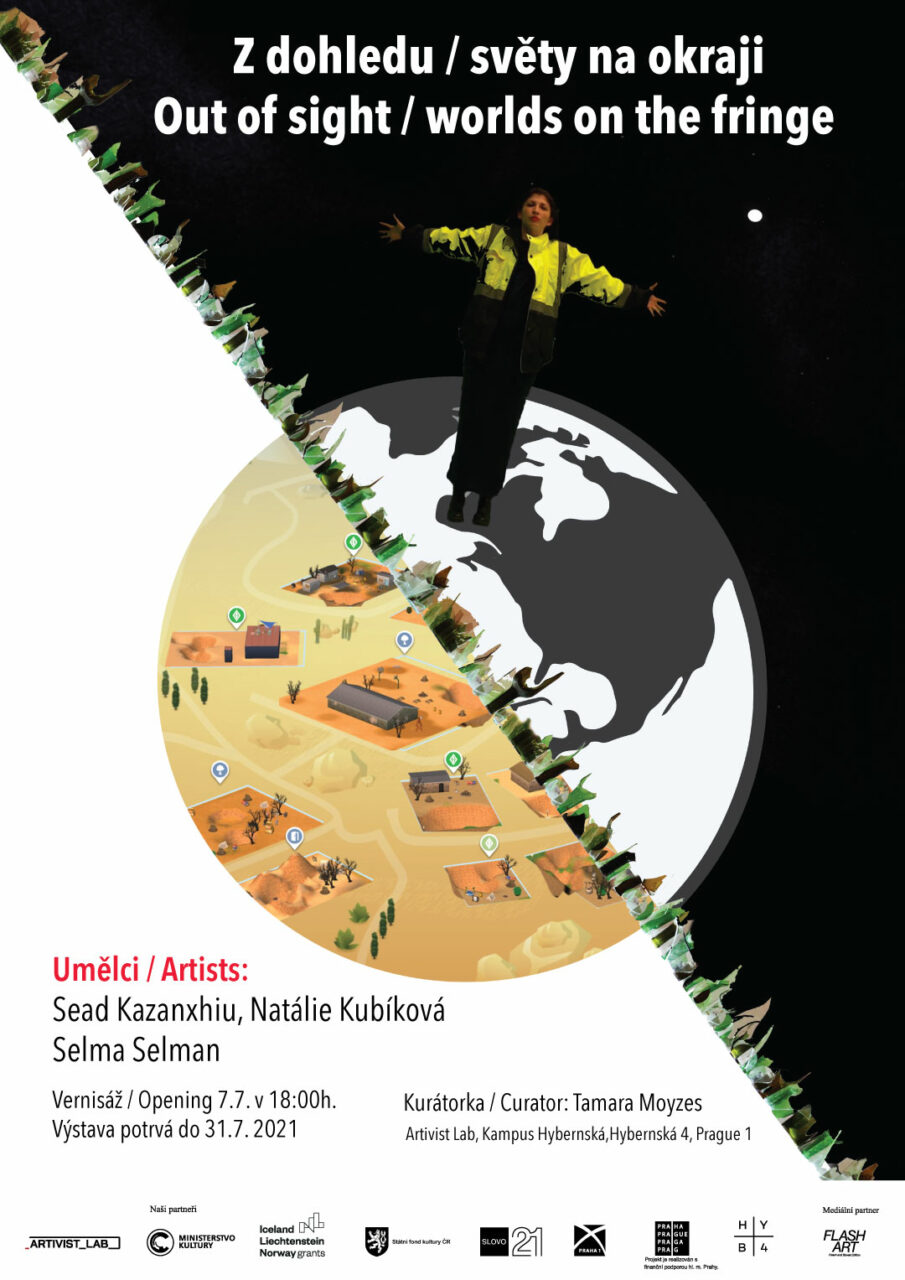For English scroll down
Z dohledu / světy na okraji
Umělci/kyně: Sead Kazanxhiu, Selma Selman, Natália Kubíková
Vernisáž: 7.7. 2021
Výstavá potrvá: 8.7. – 31.7. 2021
Během pandemie covidu-19, jsme byli svědkem obviňování marginalizovaných skupin z šíření nákazy, zejména lidí jiné barvy pleti, minoritní sexuální orientace či genderové identity, osob se statusem imigranta či bez státní příslušnosti, a chudých lidí. Jejich veřejná ostrakizace vedla k eskalaci diskriminace a aplikaci selektivních opatření, čímž byla významně dotčena jejich lidská a občanská práva. V Evropském kontextu byli jako hrozba pro veřejné zdraví označeni Romové. Interpretace pandemie jako události bezprecedentního rozsahu a významu podporuje vnímání současnosti jako výjimečného stavu, dějinného zlomu. Tento diskurz tak legitimizuje radikalizaci postojů vůči marginalizovaným skupinám a otvírá prostor pro zneužívání pravomocí v rámci provádění mimořádných opatření. Tato populistická instrumentalizace strachu není novodobým fenoménem. Vznik či šíření epidemie bývalo často spojováno s “cizorodými” nebo odlišnými skupinami a Romové a Židé jako původem neevropská etnika se stávali opakovaně obětními beránky. Nicméně, co odlišuje současný anti-cikanismus od jiných forem rasismu v Evropě je jeho institucionalizace.
Tendence vládnoucích tříd vymezovat, rozčleňovat a přetvářet fyzické prostředí a sociální prostor pomocí materiálních a symbolických prostředků za účelem regulace pohybu lidí, toku zdrojů, zboží, služeb, a vztahů mezi jednotlivými subjekty je historická konstanta. Co je proměnlivé, je ideologický základ, na jehož základě se kategorizuje a člení, a účely těchto strategií. Dichotomie mezi Východem/Západem, centrem/periférií, městem/venkovem, mladými/starými, ne/přáteli lidu …jsou opakujícími se motivy v politickém diskurzu různých minulých i současných režimů. Tyto sociálně konstruované hranice a kategorie, ale zároveň formují naši realitu. Evropocentrismus a rasismus 19. století, rozlišující mezi civilizovanými a necivilizovanými společnostmi, legitimizoval evropský kolonialismus, který začal socio-ekonomicky polarizovat globální Sever a Jih. Tato hranice nerovnosti je udržována mezinárodní dělbou práce, na které se podílí nadnárodní společnosti. Státy i korporace využívají v rámci vládnutí/řízení i kategorizaci a hierarchizaci, na jejichž základě přidělují všemu, co spadá do jejich sféry, místo, roli, význam, hodnotu. Skupiny a populace, které nesplňují specifická kritéria, jsou marginalizovány, vykořisťovány a vytlačovány na okraj společnosti, na periferii světa.
Výstava nazvaná Z dohledu / světy na okraji reaguje na etnizaci pandemie v Česku a Evropě, nicméně konceptuálním rámcem výstavy je univerzálnější téma hranic, inkluze, vyloučení jako univerzální vzorec vlastní všem lidským společenstvím, a tudíž faktor determinující lidskou sociabilitu. Tímto obecnějším zaměřením se vyjadřuje k sociální diferenciaci jako politické strategii, a odkazuje tak k tíživé situaci lidí žijících na okraji v současnosti i minulosti.
Selma Selman toto téma pojednává v rámci globálních dějin lidstva, kdy se zamýšlí nad místem člověka v přírodě a povahou našeho bytí ve světě. Dílo Seada Kazanxhiu je výpovědí o sociálním rozkolu ve společnosti a křehkosti lidských vztahů jako inherentních rysech lidského společenství. Jedině dílo Natálie Kubíkové reaguje přímo na radikalizaci diskriminační politiky vůči Romům v České a Slovenské republice a poukazuje na katastrofické dopady dlouhodobé strukturální nerovnosti, institucionálního rasismu a populistického anti-cikanismu v kontextu globální zdravotní krize.
V performanci No Spacez roku 2019, Selma Selman personifikuje náš egocentrismus jako velké tělo. Ze své podstaty neukojitelné tělo si nárokuje a uzurpuje celou planetu. Autorka reflektuje na antropocentrismus, který je nejen sebevražedný, ale letální pro veškerý život na této planetě. Dílo je zároveň kontemplací potenciálu lidstva ke změně tváří tvář událostem, jež přesahují naši kapacitu plně jim rozumět a vyrovnat se s nimi.
On the Wall z roku 2015 Seada Kazanxhiu je sémanticky bohatá aluze na téma hranic v lidských vztazích a společnosti. Instalace je uměleckým ztvárněním reálně existujících objektů, které tvoří součást koloritu albánské urbánní krajiny–zdi okolo domů, osázené skleněnými střepy místo ostnatého drátu. Estetičnost a určitá hravost reálné formy objektu kontrastují se surovou explicitností obsahu. Avšak hlubší vrstvy symbolismu díla On the Wall mluví o křehkosti a zranitelnosti. Fyzickou zeď jako nejpřímější ztělesnění sociální distance lze chápat jako externalizaci zdí uvnitř nás, naše mentální a emocionální omezení, které nás činí rigidními, uzavřenými, defensivními. Analogicky, střepy v tomto kontextu mohou implikovat nejen pouze úmysl zranit, ale také stav vnitřní zlomenosti a rozbité vztahy.
Dílo Natálie Kubíková Žehra reaguje na porušování lidských práv ve východoslovenské romské osadě Žehra z roku 2020. Uzavření osady a dozor armády a policie prezentované jako karanténní opatření nelze interpretovat jinak než jako diskriminaci na etnickém základě. Kubíková si vybrala médium videohry, ve kterém vytvořila podle reálných podkladů virtuální model fyzického a sociálního prostředí uzavřené a hlídané romské osady. Síla a důvtip díla spočívají především v tom, že autorka použila předlohu existující videohry, the Sims 4, ve které je hráč architektem fyzického a sociálního prostředí. Tento virtuální svět zabydluje různými charaktery, o jejichž základní a další potřeby pečuje a pomáhá jim řešit výzvy a nástrahy běžného života. V rozporu s tím, reálné odříznutí osady od světa signalizuje naprostý nezájem o potřeby jejích obyvatel a má za následek minimální ochranu před nebezpečím. Žehra má tudíž zvláštní pravidla oproti originální verzi, která hráč může, či nemusí dodržovat.
Sead Kazanxhiu (narozený v roce 1987 ve Fier, od roku 2012 žije v Tiraně) je vizuální umělec z jihozápadní Albánie. Vystudoval malířství (2006–2010) na vysoké škole umělecké v Tiraně.
Kazanxhiu komentuje postavení Romů v souvislosti s nespravedlivým zacházením. Stojí v opozici vůči rasově předpojatým dynamikám, které bohužel i nadále formují současné evropské světové názory, denně, uvnitř i vně oficiálních politických arén. Jeho tvorba se snaží obnovit důstojnost komunitě, která byla tvrdě a nespravedlivě tlačena na okraj evropské demokracie. Kazanxhiu je jedním z nejvíce zapojovaných mladších protagonistů na současné albánské kulturní scéně. Vystavoval v Tiraně, Budapešt, Bruselu, Praze, Brně, Gotenburgu, Berlíně, Drážďanech, Krakově, Bukurešti a v New Orleans.
https://seadkazanxhiu.wixsite.com/visualart
Selma Selman (narozená v roce 1991) je umělkyně romského původu pocházející z Bosny a Hercegoviny. V roce 2014 získala titul bakaláře výtvarných umění na katedře malířství na univerzitě Banja Luka. V roce 2018 absolvovala na Syracuse University v oboru transmédií, vizuálního a divadelního umění. Cílem jejích děl je ochrana ženských těl a uzákonění cross-skalárního přístupu ke kolektivní emancipaci utlačovaných žen. Její hledání po současném politickém odporu vychází z její osobní zkušenosti s útlakem z různých směrů a měřítek. Selma je také zakladatelem organizace „Get The Heck To School“, jejímž cílem je posílit postavení romských dívek po celém světě, které čelily ostrakizaci ze společnosti. Selma Selman v současné době žije a pracuje v Bihacu, BIH a v New Yorku, USA.
https://www.selmanselma.com/
Natálie Kubíková je kurátorka, nezávislá vizuální umělkyně a spolukurátorka platformy „KUKU kolektiv“. Její hlavní praxe je spojena s podporou vznikajících místních LGBTQ+ umělců, feminismu a politiky post kolonialismu v oblasti bývalého Československa a jeho historických přilehlých oblastí. Pracuje se současnými sociálními přesahy, LGBTQ+ komunitou, psaním a organizováním komunity.
https://novamedia2.space/?p=63
Kuátorka: Tamara Moyzes
Text: Nikol Ludlová
Výstava je součástí programu 23. ročníku Světového romského festivalu Khamoro.
Festival KHAMORO se stal jedním z nejvýznamnějších kulturních romských projektů nejen v České republice, ale v celé Evropě. Festival pořádá SLOVO 21, z. s. a Studio Production Saga, s.r.o a jako jeho organizátoři se snažíme přispět nejen k profesionální prezentaci romské kultury a umění, ale také zachytit aktuální témata týkající se postavení Romů.
Spoluorganizátoř: Slovo 21, Kampus Hybernská
Výstava je financována z Fondů EHP 2014–2021, Program Kultura.
Out of sight / worlds on the fringe
Artists: Sead Kazanxhiu, Selma Selman, Natália Kubíková
Opening: 7.7. 2021
The exhibition will last 8. 7.-31. 7. 2021
During the COVID-19 pandemic, we have witnessed blaming of marginalized groups for spreading the virus, particularly the people of colour, people with different sexual orientation/gender expression, immigrant and non-state persons, or poor people. Their public ostracizing as a threat to the public health escalated discrimination against them and in many cases entailed violation of their human and citizenship rights by subjecting them to restrictive measures not applied to majority populations. In the European context, the chief target of this concurrent politicization of the pandemic has been the Roma. The interpretation of pandemic as an event of unprecedented magnitude shapes our collective perception of the present time as the “state of exception,” a historical rupture. The discourse provides the political opportunists with legitimization for exclusionary politics and a leeway for misuse of emergency powers in its realization. This populist instrumentalization of societal fears is not novel as ample historical evidence demonstrates. Epidemics often sparked hatred and blame of the ‘other’ and Roma and Jews as representatives of non-European peoples were frequent scapegoats. However, what is alarming and what distinguishes anti-gypsyism from other forms of racism in contemporary Europe is the involvement of the state in the production of these discriminatory norms, knowledge, and politics.
Disposition of ruling classes to demarcate, compartmentalize and shape physical and social space, and regulate the movement of people and transfer of resources within and across these demarcations is a historical constant. What varies is the ideology underlying categorization and division, and the purpose of these strategies. The East/West, centre/periphery, city/country, young/old, enemies/friends of the state… have been recurrent tropes of political discourse of various past and present regimes. These socially constructed boundaries and categories however impact and shape our reality. The 19.th century eurocentrism, differentiating between the civilized and uncivilized societies, legitimized European colonialism which is at the root of today’s socio-economic divide between the Global North and South – a divide that has widened by the activities of transnational corporations. What both, states and economic elites, have in common, is their drive for categorizing and ranking people as a basis for the politics of in/exclusion and division of labour. It is the people falling outside the specific social criteria that get marginalized, exploited and expulsed to live on the fringes of the world.
The exhibition entitled Out of sight / worlds on the fringe is aimed as social commentary on the pandemic ethnicization in the Czech Republic and Europe, however, conceptually, it addresses the underlying issue of all forms of politicization and that is the universal pattern in human interaction of setting social boundaries and hierarchies through various means, discursive, and spatial and therefore it speaks about and is concerned with the precarity of life at the margins of all human groups, past and present. The works on display, each in its way, speak on the limits and potential of human sociability. Selma Selman takes a global perspective, when rethinking the human place in nature and the way of our being in the world. The work by Sead Kazanxhiu is essentially a statement on social division and the fragility of human relationships as part of the human condition. Only the work by Natálie Kubíková is a direct response to the radicalization of exclusionary politics in the Czech and Slovak Republics drawing attention to the cataclysmic implications for Romani populations of the effects of long-term structural inequality and exclusion, institutional racism, and populist anti-gypsyism in the context of a large-scale health crisis.
In her video performance No Space from 2019, Selma Selman impersonates our egocentrism as the big body. Being essentially insatiable, the body claims and usurps all the space there is. Pointing to the anthropocentrism that is not only suicidal but lethal to all life on this planet, the author reflects on the distorted way we currently embody our “humanity” and ponders the potential for change in the face of events that are beyond our capacity to comprehend and immediately deal with.
On the Wall from 2015 by Sead Kazanxhiu is a semantically rich allusion on the topic of boundaries in society and individual human relationships. The installation is an artistic interpretation of real objects occurring in Albanian urban landscapes–the protective walls around the people’s premises reinforced in their function by crown-shaped glass fragments. The esthetics of the form of the real object contrast with the raw explicitness of the message. However, the deeper layers of the symbolism of the work On the Wall speak about fragility and vulnerability. The physical wall as one of the most explicit constitution of a social boundary can be interpreted as the externalization of the walls within, our mental and emotional constraints that make us rigid, closed and defensive. Analogically, the broken glass does not connote merely the intention to hurt, but implies the state of being shattered inside and the broken human relationships.
Natálie Kubíková in her work Žehra responds to the violation of human rights in the Eastern Slovakian Roma settlement of Žehra by local and central authorities in spring 2020. The settlement was isolated from the outside world and guarded by national army and local police which was clearly an application of a selective confinement measure on ethnic grounds. Kubíková used the medium of video game to create a virtual model of physical and social space of the quarantined and guarded Romani settlement. The strength and ingenuity of her work lies in the fact that author used a template of an existing video game, the Sims 4 where the player is an architect of a physical and social space attending to the basic and other needs of the characters, he/she created, and responding to common challenges and dangers of life. In contrast, a quarantined settlement in real life entails disregard for the needs of the inhabitants and minimal protection against the dangers of life. Žehra therefore has a different set of rules which the player is free to dis/respect.
Sead Kazanxhiu (born in 1987 in Fier and based in Tirana since 2012) is a visual artist who comes from a family of Roma ethnic minority from southwest Albania. He was trained as a painter at the University of Arts in Tirana (2006 – 2010), where he obtained his bachelor degree. Following his studies, he continued to work primarily in the medium of painting, whereas his more recent practice has expanded into sculpture, installation, video, and public space interventions. He exhibited in Tirana, Budapest, Brussel, Prague, Brno, Gothenburg, Berlin, Dresden, Krakow, Bucharest and New Orleans.
Natálie Kubíková is a female Prague based curator, freelance visual artist and co-curator of curatorial platform ”KUKU collective”. Her main practice is associated with supporting emerging local queer artists, feminism and the politics of post colonialism in the area of former Czechoslovakia and it’s historic adjacent areas. She works with contemporary social overlaps, queer community, writing and community organizing.
Selma Selman (b.1991) is from Bosnia and Herzegovina and is of Romani origin. She earned her Bachelor of Fine Arts in 2014 from Banja Luka University’s Department of Painting In 2018 she graduated from Syracuse University with a Master of Fine Arts in Transmedia, Visual and Performing Arts. In her art works, the ultimate aim is to protect and enable female bodies and enact a cross-scalar approach to collective self-emancipation of oppressed women. Selma’s search for functional, contemporary political resistance stems from her personal experience with oppression from various directions and scales. Selman is also the founder of the organization ”Get The Heck To School” which aims to empower Roma girls all around the world who faced ostracization from society and poverty. Selma Selman currently lives and works in Bihac, BIH and New York, USA.
Curator: Tamara Moyzes
Text by: Nikol Ludlová
The exhibition is part of the program of the 22nd World Roma Festival Khamoro.
The KHAMORO Festival has become one of the most important Roma cultural projects not only in the Czech Republic, but in the whole of Europe. The festival is organized by SLOVO 21, z.s. and Studio Production Saga, s.r.o and as its organizers we try to contribute not only to the professional presentation of Roma culture and art, but also to capture current topics related to the position of Roma.
Co-organizers: Slovo 21, Kampus Hybernská
The exhibition is funded by the EHP Funds 2014–2021, Culture Program.

